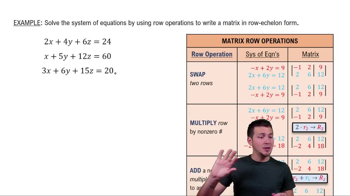Table of contents
- 0. Review of Algebra4h 16m
- 1. Equations & Inequalities3h 18m
- 2. Graphs of Equations43m
- 3. Functions2h 17m
- 4. Polynomial Functions1h 44m
- 5. Rational Functions1h 23m
- 6. Exponential & Logarithmic Functions2h 28m
- 7. Systems of Equations & Matrices4h 6m
- 8. Conic Sections2h 23m
- 9. Sequences, Series, & Induction1h 19m
- 10. Combinatorics & Probability1h 45m
7. Systems of Equations & Matrices
Introduction to Matrices
Problem 43b
Textbook Question
In Exercises 37 - 44, perform the indicated matrix operations given that A, B and C are defined as follows. If an operation is not defined, state the reason.
4 0 5 1 1 - 1
A = - 3 5 B = C =
0 1 - 2 - 2 - 1 1
A(BC)
 Verified step by step guidance
Verified step by step guidance1
First, identify the dimensions of matrices B and C. Matrix B is 2x2 and matrix C is 2x2.
Check if the multiplication BC is defined. Since the number of columns in B (2) matches the number of rows in C (2), BC is defined.
Perform the matrix multiplication BC. Multiply each element of the rows of B by the corresponding elements of the columns of C and sum them up.
Next, identify the dimensions of matrix A, which is 3x2, and the resulting matrix BC, which will be 2x2.
Check if the multiplication A(BC) is defined. Since the number of columns in A (2) matches the number of rows in BC (2), A(BC) is defined.
Recommended similar problem, with video answer:
 Verified Solution
Verified SolutionThis video solution was recommended by our tutors as helpful for the problem above
Video duration:
6mPlay a video:
Was this helpful?

 4:35m
4:35mWatch next
Master Introduction to Matrices with a bite sized video explanation from Patrick Ford
Start learningRelated Videos
Related Practice











